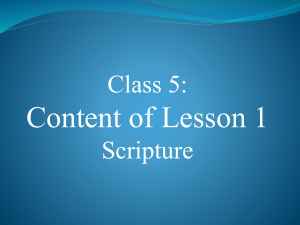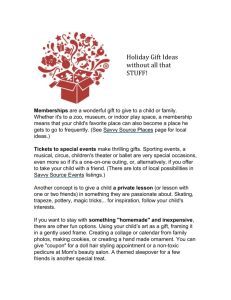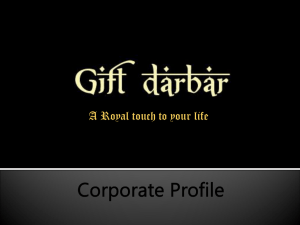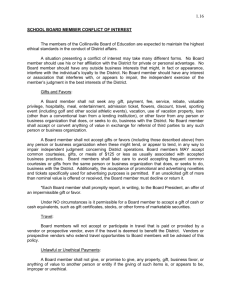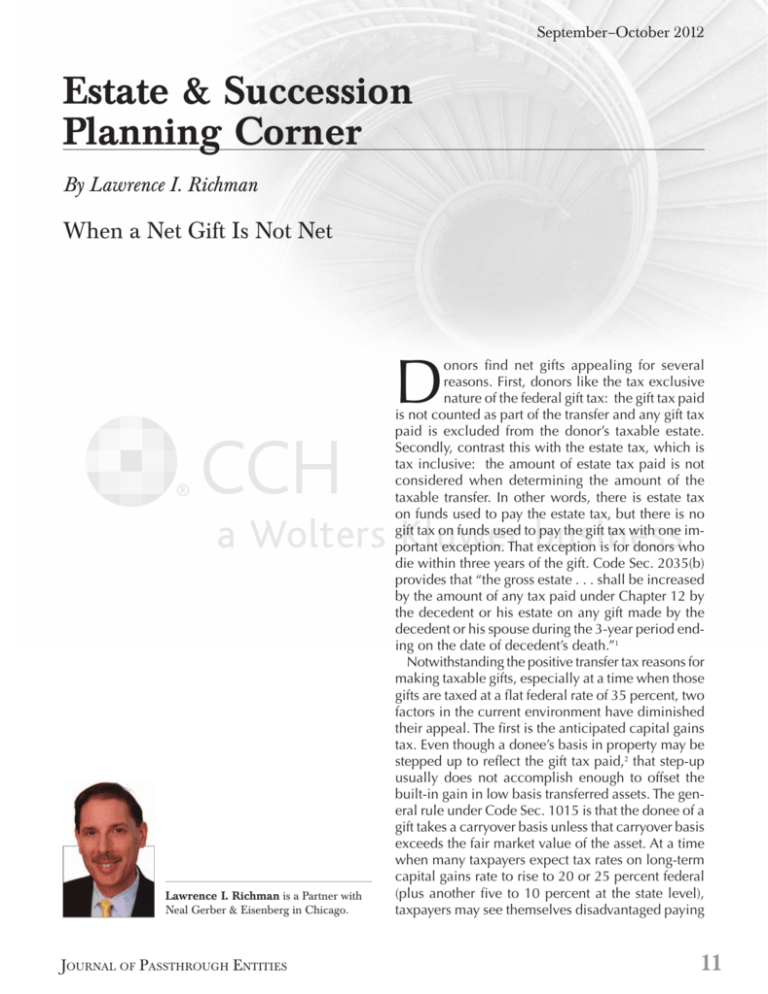
September–October 2012
Estate & Succession
Planning Corner
By Lawrence I. Richman
When a Net Gift Is Not Net
D
Lawrence I. Richman is a Partner with
Neal Gerber & Eisenberg in Chicago.
JOURNAL OF PASSTHROUGH ENTITIES
onors find net gifts appealing for several
reasons. First, donors like the tax exclusive
nature of the federal gift tax: the gift tax paid
is not counted as part of the transfer and any gift tax
paid is excluded from the donor’s taxable estate.
Secondly, contrast this with the estate tax, which is
tax inclusive: the amount of estate tax paid is not
considered when determining the amount of the
taxable transfer. In other words, there is estate tax
on funds used to pay the estate tax, but there is no
gift tax on funds used to pay the gift tax with one important exception. That exception is for donors who
die within three years of the gift. Code Sec. 2035(b)
provides that “the gross estate . . . shall be increased
by the amount of any tax paid under Chapter 12 by
the decedent or his estate on any gift made by the
decedent or his spouse during the 3-year period ending on the date of decedent’s death.”1
Notwithstanding the positive transfer tax reasons for
making taxable gifts, especially at a time when those
gifts are taxed at a flat federal rate of 35 percent, two
factors in the current environment have diminished
their appeal. The first is the anticipated capital gains
tax. Even though a donee’s basis in property may be
stepped up to reflect the gift tax paid,2 that step-up
usually does not accomplish enough to offset the
built-in gain in low basis transferred assets. The general rule under Code Sec. 1015 is that the donee of a
gift takes a carryover basis unless that carryover basis
exceeds the fair market value of the asset. At a time
when many taxpayers expect tax rates on long-term
capital gains rate to rise to 20 or 25 percent federal
(plus another five to 10 percent at the state level),
taxpayers may see themselves disadvantaged paying
11
Estate & Succession Planning Corner
to net gifts notwithstanding payment by the donees
gift tax at 35 percent only to have the donee pay a
of the gift tax. The Tax Court reasoned that to read
combined federal and state capital gains rate of a like
Code Sec. 2035(b) literally would be “wholly inconamount at a later date.
sistent with Congress’ goal of sharply distinguishing
A second factor discouraging the current making of
deathbed gifts from other gifts and eliminating the
taxable gifts is the fact that the payment of gift taxes
disparity of treatment between deathbed gifts and
diminishes a taxpayer’s liquidity.
transfers at death.”7
One scenario in which the factors discouraging taxable gifts is relatively absent is when a net gift is made
This public policy substance over statutory form
by a surviving spouse of property inherited from the
argument was echoed in the recent decision in A.W.
deceased spouse. The unlimited marital deduction
Morgens Est.,8 in which the Court of Appeals for the
rules allow for a full step-up in basis to fair market
Ninth Circuit expanded the application of the Code
value for the deceased spouse’s assets (something
Sec. 2035(b) net gift holding in S.C. Sachs Est.9 to
particularly important when dealing with “negative
Code Sec. 2519 transfers made within three years
basis” assets). That increase in basis diminishes conof death. Code Sec. 2519 applies when a surviving
cerns about the arbitrage between gift tax and federal
spouse transfers the remainder interest in a QTIP
and state capital gains tax rates.
trust. The gift is deemed to be a gift of the entire
A net gift is a technique that minimizes the liquidity
interest in the QTIP and is valued in two parts: one
requirements of a gift by requiring as a condition of
part consists of the surviving spouse’s income interthe gift that the donee asest and is deemed a gift
sume the obligation to pay
by the surviving spouse
One scenario in which the factors
the amount of gift tax on
taxable under Code Sec.
the gift.3 Liquidity needs
2511; the other part is the
discouraging taxable gifts is
remainder interest in the
are reduced because the
relatively absent is when a net
QTIP, which is a deemed
gift tax payable by the dogift is made by a surviving spouse
transferred on account of
nee on the gift is deducted
the transfer of the income
from the fair market value
of property inherited from the
interest and is computed
of the assets transferred in
deceased spouse.
by deducting the value of
determining the value of
the income interest from
the gift.4 The calculation
the value of the QTIP. Code Sec. 2519 governs the gift
to determine the amount of the gift is an interrelated
tax treatment of the transfer of the remainder interest
formula where the value of the gift equals the tentain the QTIP: “The amount treated as a transfer under
tive tax divided by one plus the rate of tax. In today’s
this section . . . is equal to the fair market value of
flat 35-percent gift tax world, net gifts reduce the
the entire property subject to the qualifying income
effective tax rate by over nine percent to less than
interest . . . less the value of the qualifying income
26 percent. By reducing liquidity requirements by
interest in the property on the date of disposition.”10
over 25 percent and by shifting the liquidity required
to the donee, net gifts can be immensely appealing
Like a net gift, the value of the gift can be reduced by
to surviving spouses—even if the donee’s gift tax
the amount of gift tax payable and the responsibility
payment is financed by the surviving spouse donor
for the gift tax lies with the transferee and not the
making a loan to the donee.
donor. Code Sec. 2519 gifts, however, are subject to
Sometimes, however, a net gift may not be the transCode Sec. 2207A(b), pursuant to which the surviving
fer tax bargain anticipated by the parties. This occurs
spouse/donor has the statutory right to recover the
when the donor dies within three years of the gift. In
gift tax paid—and is deemed to have made a gift of
these situations, the estate tax treatment of the gift tax
such amount if the right to recover is not enforced.
paid on a net gift has been the subject of litigation,
In A.W. Morgens Est., the court stated that “this
given the literal reading of Code Sec. 2035(b), which
case presents the question whether gift taxes paid
bases estate inclusion on the amount of gift tax paid
by the donee trustees of a Qualifying Terminable
“by the decedent or his estate.”5
Interest in Property (QTIP) trust, based on a 26 USC
§2519 deemed inter vivos transfer of the QTIP propIn S.C. Sachs Est.,6 the decedent made net gifts
erty within three years of the donor’s death, must be
within three years of death. The Tax Court held that
included in the transferor’s gross estate under the
Code Sec. 2035(b) included the gift tax attributable
12
©2012
CCH. All Rights Reserved.
September–October 2012
so-called ‘gross-up rule’ of Section 2035(b).”11 The
court held the net gift analogy persuasive. “As in a
net gift, the financial responsibility for the gift taxes
on a QTIP transfer rests on the donees rather than the
donor, even though the shift occurs by contract in a
net gift and by the operation of Section 2207A in a
QTIP transfer. However, as in a net gift the liability
for the gift taxes remains with the donor.”12
By not treating the gift tax liability generated by the
early termination of a QTIP any differently than any
other gift tax liability paid by the donee within three
years of the death of the donor, the Ninth Circuit Court
of Appeals cautions taxpayers on the limitations of
net gift tax planning and confirms Treasury’s position
as expressed in the Regulations that QTIP transfers
are normally taxed as net gifts.13 Notwithstanding the
three-year inclusion rule of Code Sec. 2035(b) which
can make net gifts not so net, net gifts made by surviving spouses of inherited property can have significant
transfer tax appeal.
ENDNOTES
1
2
3
Code Sec. 2035 (b).
Code Sec. 1015 (d).
See Rev. Rul. 81-223, 1981-2 CB 189; and
Rev. Rul. 79-398, 1979-2 CB 338, in which
the IRS held that even though the donee is
the payor of the gift tax, the donor’s unified
credit must first be taken into account and
any remaining credit reduced before calculating the gift tax payable.
4
5
6
7
See Rev. Rul. 75-72, 1975-1 CB 310.
Code Sec. 2035(b).
S.C. Sachs Est., 88 TC 769, CCH Dec.
43,823, aff’d in part and rev’d in part on
another ground, CA-8, 88-2 USTC ¶13,781,
856 F2d 1158.
S.C. Sachs Est., 88 TC at 777, CCH Dec.
43,823.
8
9
10
11
12
13
A.W. Morgens Est., 133 TC 402, CCH Dec.
58,027, aff’d, CA-9, 2012-1 USTC ¶60,645.
See S.C. Sachs Est., supra note 6.
Reg. §25.2519-1(c)(1).
Supra A.W. Morgens Est., 2012-1 USTC
¶60,645.
Supra note 11.
See Reg. §25.2519-1(c)(4).
This article is reprinted with the publisher’s permission from the JOURNAL OF PASSTHROUGH ENTITIES,
a bi-monthly journal published by CCH, a Wolters Kluwer business. Copying or distribution
without the publisher’s permission is prohibited. To subscribe to the JOURNAL OF PASSTHROUGH
ENTITIES or other CCH Journals please call 800-449-8114 or visit www.CCHGroup.com.
All views expressed in the articles and columns are those of the author and
not necessarily those of CCH or any other person. All Rights Reserved.
JOURNAL OF PASSTHROUGH ENTITIES
13

